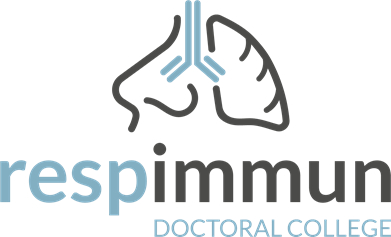
respimmun.at
• Böhm
• Heinemann
• Höfler
• Kargl
• Kwapiszewska
• Leithner
•Marsche
•Marsh
Moissl-Eichinger ⏩
• Olschewski A
• Strobl
• Heinemann
• Höfler
• Kargl
• Kwapiszewska
• Leithner
•
•
• Olschewski A
• Strobl


The RESPImmun Faculty

|
Christine MOISSL-EICHINGER, PhDThe role of the microbiome in chronic rhinosinusitis and sinubronchial syndrome |
|
Department of Internal Medicine, Medical University of Graz,
Auenbruggerplatz 15, A-8036 Graz;
| |
| websites: [RESPImmun] [MUG] | |
| • Profile ⏬ • Curriculum vitae • PhD students • Grants • Publications | |
Christine Moissl-Eichinger is a microbiologist focusing on the microbiome and its interplay with the human body and the environment. Her specific expertise is the analysis of the archaeome, as well as the (living) microbiome in low-biomass or challenging microbial environments, such as the respiratory tract. In recent studies, she enlightened the presence of archaea in human lung, as well as the interplay of the microbiome with throat cancer and anosmia. Her goal is to find microbial solutions to human disease. Within RESPImmun she closely collaborates with Peter Valentin Tomazic (CRS), Herbert Strobl (immune cells), Eva Böhm (allergic asthma) and Horst Olschewski (patient samples).
Project
Project 2: The role of the microbiome in chronic rhinosinusitis and sinubronchial syndromeCo-PI: Vasile Foris
Background
The respiratory tract harbors numerous microorganisms, and in particular the lung, originally considered to be largely sterile, contains an endogenous microbial community. The microbiome in the respiratory tract varies depending onHypothesis and objectives
We hypothesize that chronic rhinosinusitis and the sinubronchial syndrome is associated with a dysbiotic microbiome (bacterial and archaeal) profile and function in the respiratory tract and that the gastrointestinal tract could serve as a potential source of infection (gut-lung axis). In this project, we will analyze the microbial community and its function (metatranscriptome) from upper to lower respiratory and gastrointestinal tract. In order to decipher the interplay of the microbiome and the human body, we will analyze the mucus and BAL with respect to the proteome / metabolome. We will correlate our findings with the clinical information derived from the samples and corresponding patients in order to obtain insights into the diversity, activity, function, dispersal and distribution of archaea and bacteria in CRS patients, the CRS sub-groups (with / without polyps) and patients with sinubronchial syndrome.Methodology
We will use different methods in state-of-the-art microbiome research, including 16S rRNA gene-based next-generation sequencing, propidium monoazide treatment of the samples (to distinguish living and dead cells), fluorescence in situ hybridization to visualize the microorganisms and metagenomics / metatranscriptomics, as well as metabolomics/proteomics. The PhD student will specifically be trained in Archaea microbiology, and learn to detect and visualize these microorganisms. In year 1, the student will be involved in sampling and sampling processing (amplicon-sequencing, PMA treatment, FISH). InInput from collaborations within the RESPImmun programme
- Peter Valentin Tomazic and Horst Olschewski will support patient recruitment and sample collection,
- Peter Valentin Tomazic will support this study with his expertise in proteome / metabolome analyses of mucus samples,
- Grażyna Kwapiszewska will support the project with her expertise in lung physiology,
- Eva Böhm and Leigh Marsh will support this project with their expertise in allergic asthma, and
- Herbert Strobl with knowhow on immune cells.